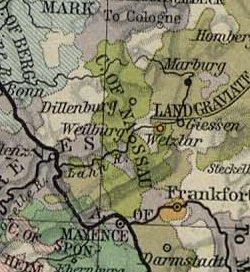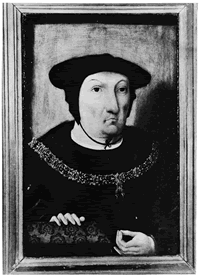
Albrecht III was Elector of Brandenburg from 1471 until his death, the third from the House of Hohenzollern. A member of the Order of the Swan, he received the cognomen Achilles because of his knightly qualities and virtues. He also ruled in the Franconian principalities of Ansbach from 1440 and Kulmbach from 1464.

Adolf was the count of Nassau from about 1276 and the elected king of Germany from 1292 until his deposition by the prince-electors in 1298. He was never crowned by the pope, which would have secured him the imperial title. He was the first physically and mentally healthy ruler of the Holy Roman Empire ever to be deposed without a papal excommunication. Adolf died shortly afterwards in the Battle of Göllheim fighting against his successor Albert of Habsburg.

The County of Nassau was a German state within the Holy Roman Empire and later part of the German Confederation. Its ruling dynasty, the male line of which is now extinct, was the House of Nassau.

Frederick IV was Burgrave of Nuremberg from 1300, until his death in 1332. He was the younger son of Burgrave Frederick III from his second marriage with the Ascanian princess Helene of Saxony.

Bernard I of Baden was Margrave of the Margraviate of Baden from 1391 to 1431.

The Counts of Vianden, ancestors of the House of Orange-Nassau, were associated with the castle of Vianden in Luxembourg.
The House of Sponheim or Spanheim was a medieval German noble family, which originated in Rhenish Franconia. They were immediate Counts of Sponheim until 1437 and Dukes of Carinthia from 1122 until 1269. Its cadet branches ruled in the Imperial County of Ortenburg-Neuortenburg and various Sayn-Wittgenstein states until 1806.

Engelbert II of Nassau, Engelbrecht in Dutch, was count of Nassau and Vianden and lord of Breda, Lek, Diest, Roosendaal, Nispen and Wouw. He was a soldier and courtier, for some time leader of the Privy council of the Duchy of Burgundy and a significant patron of the arts.

Ottilie of Katzenelnbogen, was by marriage Margravine of Baden-Baden.
Louis II of Nassau-Weilburg was a count of Nassau-Weilburg.

John III, Lord of Bergen op Zoom or John III of Glymes was a noble from the Low Countries.

Count John of Nassau-Idstein was Count of Nassau and Protestant Regent of Idstein.
John Louis I, Count of Nassau-Wiesbaden-Idstein was the son of Count Balthasar of Nassau-Wiesbaden-Idstein and his wife Margaret of Isenburg-Bierstein. He succeeded his father in 1568 as Count of Nassau-Wiesbaden.

Adolph II, Count of Nassau-Wiesbaden-Idstein was a son of Walram IV, Count of Nassau-Idstein his wife, Bertha of Westerburg. He married in 1418 with Margaret (1404–1442), a daughter of Bernard I, Margrave of Baden-Baden. After his father's death in 1393, he ruled Nassau-Wiesbaden and Nassau-Idstein.
Balthasar of Nassau-Wiesbaden-Idstein was the youngest son of Count Philip I of Nassau-Wiesbaden-Idstein and his wife, Adriana of Glymes of Bergen, the daughter of John III of Bergen op Zoom.

Count Adolf III of Nassau-Wiesbaden-Idstein was a son of Count John II of Nassau-Wiesbaden-Idstein and his wife Mary of Nassau-Siegen (1418–1472). After his father's death in 1480, he ruled Nassau-Wiesbaden and his brother Philip ruled Nassau-Idstein. After Philip's childless death in 1509, Adolf III ruled also ruled Nassau-Idstein.
Count Louis I of Nassau-Weilburg was a son of Count John III of Nassau-Weilburg and his wife, Elisabeth of Hesse. In 1492, Louis I succeeded his grandfather Philip II as Count of Nassau-Weilburg, because his father had already died in 1480.
Count Philip of Nassau-Idstein was the youngest son of Count John II of Nassau-Wiesbaden-Idstein and his wife, Mary of Nassau-Siegen. In 1470, he married Margaret (1456–1527), the daughter of Count Palatine Louis I "the Black" of Zweibrücken-Veldenz.

Countess Margarethe von Hanau-Lichtenberg, known upon her marriage as Margarethe, Countess of Nassau-Wiesbaden-Idstein was a German noblewoman who, as the wife of Adolf III of Nassau-Wiesbaden-Idstein, was the Countess of Nassau-Wiesbaden and Nassau-Idstein.

Countess Mary of Nassau-Siegen, German: Maria Gräfin von Nassau-Siegen, official titles: Gräfin zu Nassau, Vianden und Diez, Frau zu Breda, was a countess from the House of Nassau-Siegen, a cadet branch of the Ottonian Line of the House of Nassau, and through marriage Countess of Nassau-Wiesbaden-Idstein.














